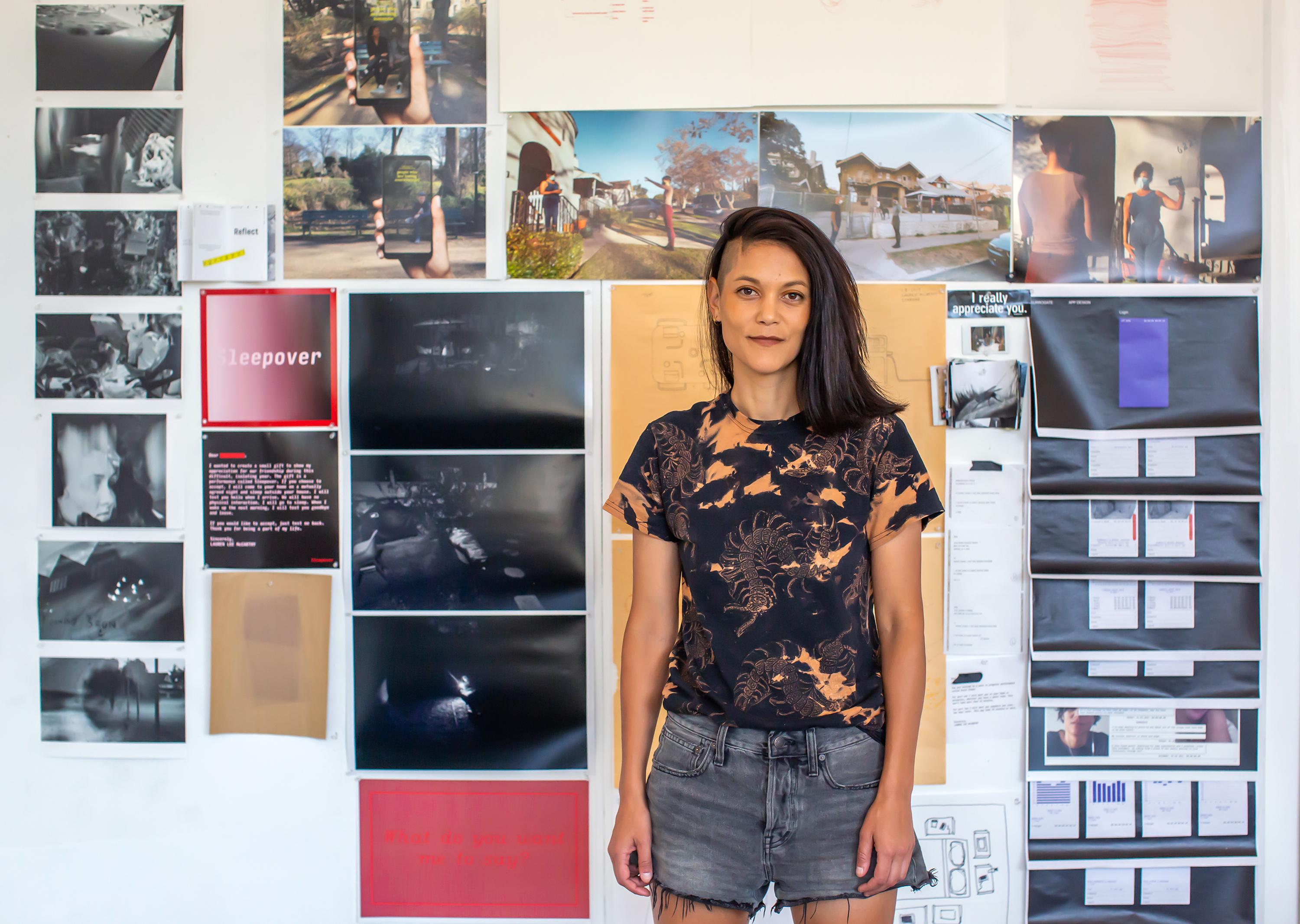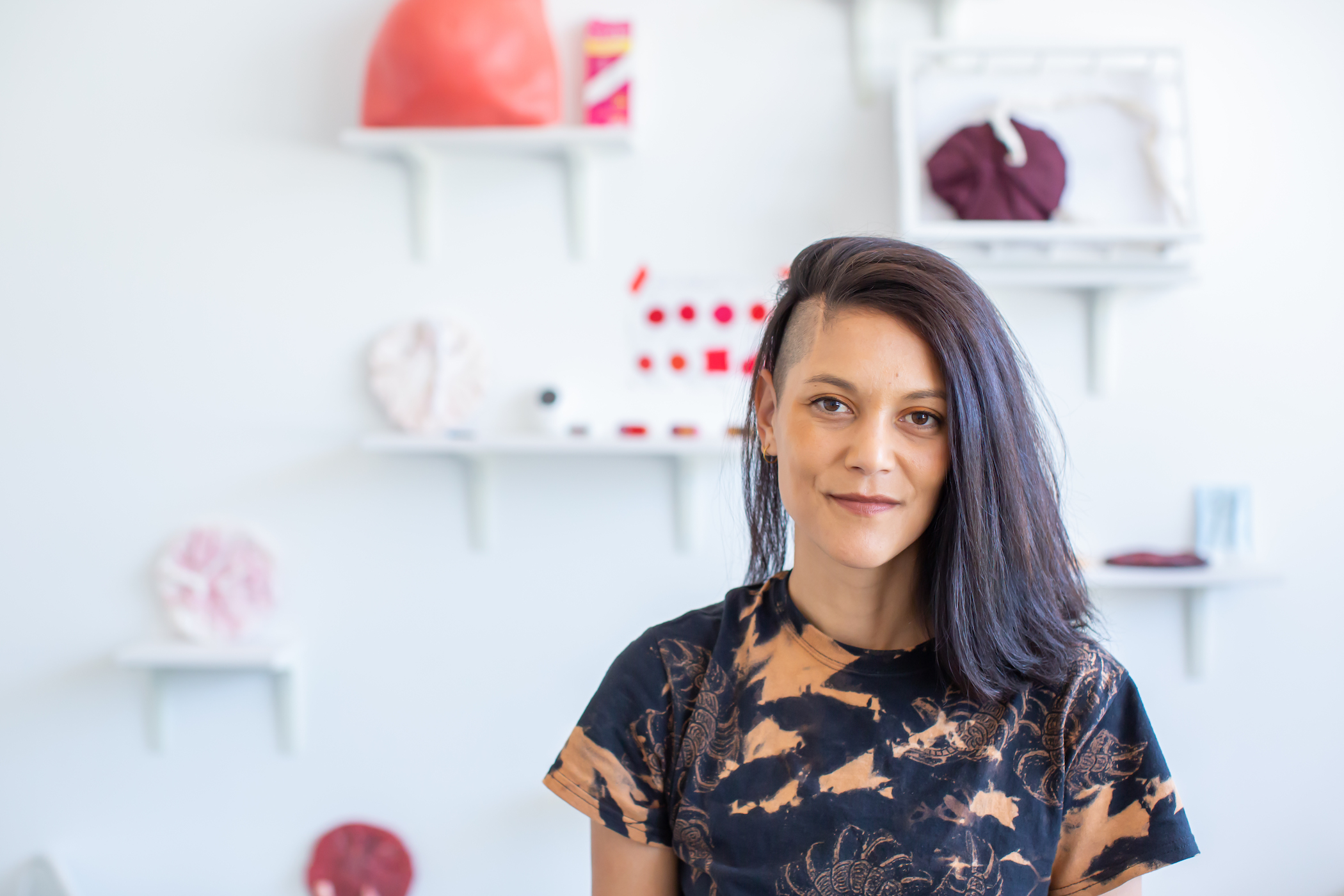Lauren Lee McCarthy: Exploring the Human Relationship with AI

The apps and tools we use are not neutral, says Stanford HAI’s new visiting artist.
Artist and computer scientist Lauren Lee McCarthy has spent days working virtually as a human “Alexa” in strangers’ homes. She’s created a 24-hour machine-driven cocktail party where software controls the actions and conversation of the human host. She’s acted as a real-life “follower” for people curious about what it would be like to have an actual — but hidden — observer.
For McCarthy, there are few things more intriguing than examining how human beings are adapting to the prevalence of artificial intelligence and the surveillance, automation, and algorithmic living it brings to their lives.
“The systems we build — both technical and social — shape the way we live together and relate to each other,” she says. “We tend to think of the apps and tools we use as a neutral presence, but they’re not neutral. There are so many design decisions that go into them based on an assumption of who the user is and what their goals are. These tools are reinforcing and accelerating the world we’re heading toward, and I feel it’s important to question all that.”
McCarthy will be pursuing those questions as the 2022-23 Visiting Artist at the Stanford Institute for Human-Centered Artificial Intelligence. Currently on sabbatical from her position as an associate professor at UCLA Design Media Arts, McCarthy creates performance-based work using installations, video, software, photography, and sculpture to explore the technological and social systems humans simultaneously build for themselves.
Questioning Technical Possibility/Social Impact
McCarthy first found herself drawn to the intersection of art and technology as an undergraduate at the Massachusetts Institute of Technology (MIT).
“I’ve always liked art, but had gotten the message early that it was just a hobby,” she says. “Math was also a good fit for me, so I started out studying computer science. At that time in 2008, it felt like there was a lot of emphasis on technical possibilities without much questioning of the social implications of those possibilities. One day, I wandered into the art department and found people who were asking those questions. I began studying both fields simultaneously and putting them together.”
Her award-winning work focuses largely on interactive performances that invite viewers to engage with her and with AI technology. In the series of work titled “Lauren,” for example, she assumes the duties of a virtual personal assistant for up to a week in homes equipped with custom-designed networked smart devices that allow her to control switches, door locks, faucets, and various electronic devices. Her attempt to be more effective than AI raises questions on the tension between intimacy and privacy, convenience versus agency, and the role of human labor in the future of automation.
“Each project asks different questions,” McCarthy says. “In this series, I was wondering what it means to invite AI into our homes. Where is the boundary between an intimate private space and a public one that can be managed and optimized?”
In another performance piece called “Follower,” McCarthy invites volunteers to download an app and sign up to be physically — and surreptitiously — followed by the artist for a day. Although participants are notified when the process begins, they never see their follower, receiving only a single photo of themselves at the end of the day. The project explores the desire on the part of some to share their lives without the complexity of forging a new relationship.
“I follow all day, but maybe they never even notice me or see me,” she says. “I have an intense experience with this person for a day, and I think they have an intense experience with me, but we never speak.”
Broadening Access and Inclusion
McCarthy is also the creator of p5.js, an open-source art and education platform designed to increase access and diversity in learning to code. She developed the platform through The Processing Foundation, which works to expand communities of technology and the arts to include those who have not historically had access to learning to code.
“When I started coding in tech spaces, I saw how the dynamics in many of them kept people from feeling welcome,” she says. “We decided to create p5.js with a different set of values, making it clear that the most important thing is that people feel they have access and are included. The community prioritizes that in every decision. The platform is very collaborative, and communities are springing up around it. It now has a user base of a few million people, has been translated into different languages, and is taught around the world.”

The Future of Life (and Art)
At HAI, McCarthy anticipates hosting guest lectures and workshops and incorporating the perspective of students and the Stanford community into an ongoing project concerning human reproduction in the age of AI.
“I’m interested in the future of reproduction, as AI increasingly provides the ability to predict outcomes in areas such as DNA sequencing and screening in utero,” she says. “What does that mean in terms of making decisions about the start of life for someone? I’m excited to talk with a lot of different people at HAI who might be thinking around these spaces and to see what art might come out of these discussions.”
Artificial intelligence, McCarthy says, is changing the dynamics of the art world, as artists consider its implications through their work, use new technological tools to create art, and deal with algorithms that increasingly determine what art is viewed online. Artists, in turn, must be among those providing computer scientists with expanded insight into the design and deployment of AI that benefits all members of society.
“If we want a world that’s more equitable, then we need to look not only at what technology we’re building but who’s doing the building,” she says. “Art is a way to bring different people into that conversation and to ask questions that aren’t always easy to ask within an engineering or science framework. It’s a way of pointing out a possible future that we may not yet have imagined. As for myself, I’m not saying ‘Here’s the future we should have.’ I’m just asking ‘What if?’ ”
Stanford HAI's mission is to advance AI research, education, policy, and practice to improve the human condition. Learn more.


